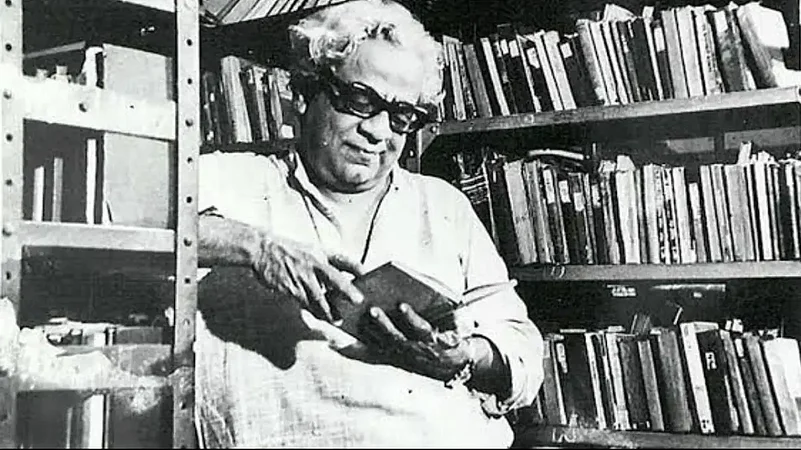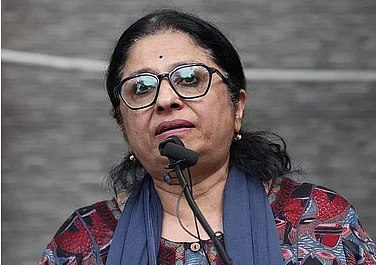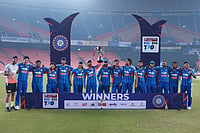If legendary cartoonist late RK Laxman were to reimagine his iconic character, the ‘common man’, Purushottam Laxman Deshpande could have been one of his model templates.
You wouldn’t look at him twice, even if the portly PL Deshpande bumped into you, at Mumbai’s Churchgate railway station during rush hour.
With his kurta-pyjama chappal attire, fleshy belly, buck teeth and thick-framed glasses, Deshpande in the 1970s-80s could be the man who sits alongside at the next table at Mumbai’s Irani cafes slurping tea from a saucer or one of the hundreds of Mumbaikars strolling around the Gateway of India, a jhola slung across one shoulder, and a paper cone of salted peanuts in hand.
You wouldn’t notice his presence unless he began to speak or read out one of his scores of essays, most of which hold a mirror to Mumbai and its people, complete with convex and concave reflections.
What RK Laxman’s equally illustrious brother RK Narayan did with Malgudi, his fictional town set in Southern India, PL Deshpande, fondly referred to as Pu La by his peer and friends, made do with Mumbai. Only, he did not need a fictional piece of geography to weave his stories around. Deshpande lived, breathed, and wrote furiously about the city, he was born in.
In a Films Division of India (FDI) documentary which provides a biographical account of his life and times, Deshpande who was 60-year-old at the time spells out his passionate obsession with Bombay. In the documentary, he recounts an instance when had just quit his brief stint in Delhi, where he worked as a producer for Doordarshan in the late 1950s-60s.
“Somebody asked me what did you like most about Delhi? My reply was, ‘The train which leaves for Bombay,’ Deshpande says in the documentary.
Deshpande's life reflected equitably the characters he fleshed out in his short stories, plays, personality sketches, films and satire. His gamut of realistic characters was dipped in the ordinary, but when commandeered by Deshpande’s craft, they came alive to tell an extraordinary story from the bowels of their everydayness.
The Deshpande clan had migrated from Ratnagiri in the Konkan to Bombay. His father, Lakshman, worked as a clerk at a paper mill in the city.
Migration to Bombay and the lives of the city’s ordinary folk were either the overlying theme or a pet undercurrent in his writing. Deshpande intensely chronicled the migration of villagers from the impoverished hamlets tucked away in the rugged reaches of the Konkan in the Sahyadri mountain range to the textile mills in the great city.
Long before, the region’s Alphonso mangoes gave Konkan’s Ratnagiri area, its unique identity and currency for its residents, the region contributed to the bulk of workforce of Bombay’s textile sector.
In the 1860s, 15 percent of persons born in Ratnagiri migrated to Bombay. The migration often led to young able-bodied men leaving for the city, leaving behind their parents in the village to fend for themselves on the frugalities of rural living and a money order from the city to cover essentials.
Deshpande’s ‘Antu Barva’ is a character sketch of aging, shriveled man from Ratnagiri, living out his last days with a grudging sense of panache in the midst of poverty. It obliquely touches upon migration and the big city. In the sketch Antu’s son has also moved to Bombay after marriage, leaving his father to his own devices in the Konkan at the mercy of a few mango, betel nut, and kokum trees.
Another overlap of Deshpande’s life with his fiction is the chronicling of the modest successes in the life of a city ‘babu’ who constantly bobs in an ocean of urban anxiety. Imagine for one moment, Mumbai’s ‘local’ train as the metropolis. Then the clerk has as much stake in the city as the men and women who travel these packed metal tubes-on-wheels, with just one part of the foot on the metal footrest by the train door.
Irrespective, Deshpande’s clerk is an integral, but anonymous element in the metropolis.
Deshpande has justification for his obsession with the lives of the city’s babus.
His father worked as a clerk. Deshpande too, was briefly employed as a clerk in the Income Tax department in Bombay. His friends, he told the FDI documentary, never believed that he would ever find a vocation as a writer.
“My school friends later told me that they did not believe I would be a writer. They felt I would take up a government job and retire as a pensioner… If men were to be divided according to class, I am middle class, because there’s blood of a clerk flowing in my veins…” Deshpande said.
His popular ‘Asami’ (I am such an individual), is a fictional biographical sketch of a clerk employed in a British firm in Bombay. The protagonist Dhondu Joshi, much like Deshpande, is also a first-generation immigrant born in Bombay, whose father migrated to the city from Ratnagiri.
Mhais (she buffalo), one of Deshpande’s most popular essays draws from a typical journey from Konkan to Mumbai in the Maharashtra government’s state transport corporation, a journey thousands of Konkanis would have undertaken after spending a summer holiday back home.
“After a while, the aroma of a ripe jackfruit, dried fish, flowers worn by women, all came together like a murder trail unravelling. Most of the other passengers were mill workers who had taken leave returning to Mumbai. But like every single time, I was returning wondering, why I had come (to the Konkan) altogether. While travelling to the Konkan, I would wonder why I am undertaking this journey and on the way back, I would wonder why did I travel at all,” Deshpande narrates in Mhais.
Its plot revolves around such a journey, where the bus knocks over a mhais and the subsequent travails of the buffalo as well as bus passengers.
The author’s celebration of the contribution of Bombay’s mill workers was also evident in his speech at the 175th performance of a cult play ‘Vastraharan’ starring late Malvani comedian actor Macchindra Kambli in the late 1980s.
“I found it particularly funny, when I was told that several of the cast and crew worked in textile mills. It is ironic that those who manufacture clothes, would make people laugh with a play like ‘Vastraharan’ (stripping of one’s robes). I am not going to praise them because they are workers employed in textile mills or other factories… I will also not say that they enacted the play well, despite the fact that they are workers. They should be solely praised on account of their unparalleled performance,” Deshpande said.
Deshpande’s passion for Bombay is evident in his essay comparing three main cities in Maharashtra, Mumbai, Pune and Nagpur.
Deshpande in his trademark craft does not make his choice of city clear. But there is enough in the details to spell out his love for Bombay, through the city’s love for cricket. A Mumbaikar, Deshpande says, is as passionate about its cricketers like CK Nayadu, Vijay Merchant as a Punekar is about his city’s history.
Mumbaikar’s especially chawl dwellers he says, have never liked guests who stay over, cramping their already meager space even more. And time… time, says Deshpande in his essay, is not tied to a Mumbaikar’s wrist but to his or her fate.
“She (Mumbai) cares only about today and tomorrow. The Mumbaikar cares little about how fast Shivaji's steed may have galloped, but more about when the next fast local train is scheduled. It is only after you come to Mumbai that you realise that the minute hand in your watch is also of great significance. In any other city, you can go through life just paying attention to the hand which denotes the hour. But not in Mumbai. Because in Mumbai your watch is tied not just to your wrist, but to your fate,” says a passage from the essay translated by Gaurav Sabnis.
The importance of housing in Mumbai, as well as the significance of chawls -- essentially affordable housing which was created to house the city’s working class, especially mill workers -- also breaks through repeatedly in this essay, among his other writing.
“Of course, if an aunt living in some chawl or apartment in Mumbai is willing to adopt you, then the prospects look bright. That's the easiest way to be born again (in Mumbai). Or you could always become a ‘ghar jamai’ (resident son-in-law). In Mumbai, the definition of a ghar jamai is someone whom you have to give your daughter as well as your house. However, if you do manage to take care of the housing issue, then there are few joys in the world as unmitigated as being a Mumbaikar, believe me,” Sabnis says in his translation.
Deshpande himself was born in a small room at the Kripal Hemraj chawl in South Mumbai’s Gaamdevi area, known among other things, for the city’s smallest lane, around just 22 inches wide.
“I did not cry like other kids. The midwife had to heat a needle and placed it on my forehead. I cried so loud that the whole of Gaamdevi would have heard it. In fact, my first bout of crying itself gave an occasion for others to laugh… My father used to work for a businessman who dealt in paper. Little did he know that his son would become a literary person and waste reams of paper,” Deshpande says in a Films Division of India documentary dedicated to him.
The chawl where Deshpande was born is still on the list of things to see in Gaamdevi heritage tours.
Deshpande would go on to immortalise life in Mumbai’s chawls in other writing too. One of his most popular works, ‘Batatyachi Chawl’ is a jovial and sarcastic account of the challenges, aspirations and the daily life of occupants of a chawl.
In an interview, the late Shiv Sena supremo Bal Thackeray, who started his career as a cartoonist, confessed his fascination for Deshpande’s craft.
“I have watched Batatyachi Chawl three to four times… No one has as many CDs and cassettes related to Pu La’s works as I do. A man like this will never be born again. Someone with such humour. Yes, some people are funny, but no one comes close to Pu la,” Thackeray told the interviewer.
Pu La Deshpande could make you see and feel his Bombay. He also provides a detailed sound scape of what a typical day in the city sounded like when he was young.
“In my childhood, Mumbai was not flooded with people or vehicles. There were loudspeakers blaring music. There was no radio, therefore you could regularly hear the hawkers’ calls. At 6 am, there would be a voice at the door ‘Bai doodh’. That was a milkman. Then there was the hail of the newspaper person, then a salt seller, the potato-onion seller. Then in the afternoon, a batli wala (scrap dealer) would come by. In the evening there would be a veni wala (garland seller). A cry soliciting Pairi hapoos (Alphonso mango) would be heard in the mango season. At 9 pm when everything was silent you could hear the sounds of the horses’ foot tap as the Victorias (horsecart) passed by and out of the dark you could see a dim light approaching. That was the kulfi wala. After the kulfi wala, that was the end of it all for the night. This was the sound clip of Mumbai at the time,” Deshpande recounts in the documentary dedicated to him.
In a city where creating just enough leg space during a daily commute is a challenge, Deshpande’s humour was carved from the daily drudgery of city life. He believed was destined to make people laugh.
“Brahmadev dispatched me to earth with just one talent, to make people laugh. When I go back tomorrow and Brahmadev asks me ‘Purshottama, I sent you down there with this talent, what have you done with it? Tell me’. Then I would tell him, ‘Brahmadev, I haven’t kept track of what I have given people. But what the people have given me, is not something that even gods and their makers are lucky enough to have. People have given something invaluable, that is their laughter.
Suppose, if someone decides to install a statue in my remembrance. I hope to God this does not happen, because statues in our country are toilets for crows. But suppose, they decide to, then I will only have them inscribe this: ‘This man made us laugh’,” Deshpande says in the documentary.


























